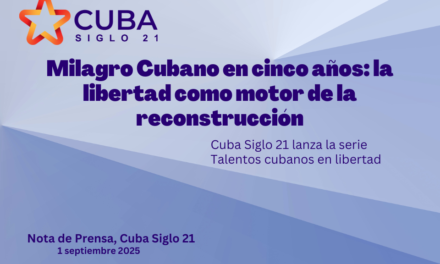Descargar informe completo en español
Download report in English
Resumen en español
Summary in English
November 17, 2025 – Amid the debate promoted by media outlets ideologically aligned with Havana and Caracas about the threat of a possible U.S. intervention in Venezuela, Cuba Siglo 21 and OCAC recall that the real intervention began in 1967 and fully achieved its objectives with the rise of Hugo Chávez to power. This intervention —originating in Cuba and sustained ever since— is what has shaped Venezuelan sovereignty for decades. If a U.S. military operation were ever to take place in that country, it could only be interpreted as an attempt to help Venezuelans free themselves from this prolonged Cuban interference, which also opened the door to the penetration of other state actors such as Russia and Iran, as well as non-state armed groups like the FARC, the ELN, and Hezbollah.
The Dossier “Cuba’s (1959–2025) permanent intervention,” is a general overview to more than six decades of military interventions, support for insurgencies, covert operations, disinformation campaigns, and strategic assistance to authoritarian regimes and the analysis of its deep, structural and real causes. Causes that will not vanish by themselves but require putting an end to the current mafia totalitarian state in the island.
Since 1959, the regime has systematically resorted to military and subversive projection to obtain resources and political support from allied powers. During the Cold War, Cuba sent its military to Algeria, Congo, Syria, Angola, and Ethiopia, carrying out some of the most extensive expeditionary operations by a small country in the 20th century. These interventions, often financed and facilitated by the USSR, had high human costs both for the Cubans sent to the front and for the local populations. In Angola and Ethiopia, where the regime played a decisive role in consolidating allied governments, the conflicts left behind more than a million dead and tens of thousands of victims of political purges, torture, and extrajudicial executions.
The report emphasizes that the interventionist pattern did not disappear after the end of the Cold War but rather transformed itself. Cuba moved from direct military intervention to a hybrid warfare model that combines intelligence, disinformation, support for repressive forces, medical missions used as instruments of influence, advice on social control and manipulation of massive migration. This repertoire has been applied in Latin America, especially in Venezuela and Nicaragua, where the Cuban presence has been decisive in sustaining governments accused by international organizations of committing crimes against humanity.
In Venezuela, Cuba restructured military counterintelligence and directly advised bodies responsible for torture, arbitrary detentions, and repression of demonstrations. According to the Dossier, this intervention was decisive in preventing internal fractures in the armed forces and ensuring the continuity of Nicolás Maduro’s regime. In Nicaragua, Cuban advice has been central to the creation of a surveillance and terror apparatus that has eliminated political opposition and consolidated the power of Daniel Ortega and Rosario Murillo.
Cuba Siglo 21 and OCAC conclude is a structural mechanism for survival derived from the persistent economic failure of the Cuban totalitarian model, whether in its previous communist form or that of the current mafia state. Cuba’s military adventures benefit from subsidies to the worst actors on the planet.
The authors highlight the economic dimension of interventionism: a system that depends on external subsidies, oil, foreign currency also obtained through medical missions, and alliances with transnational criminal networks. This structural need, derived from its administrative incompetence and totalitarian vocation—in addition to its anti-American vocation—has been at the root of its close relations with r anti-Western actors such as Russia, Iran, and China, with whom it shares information, electronic espionage capabilities, and influence strategies.
Cuba has also been developing significant capabilities in hybrid warfare. These include disinformation campaigns, cooperation with Russia and China in electronic espionage, diplomatic support, advice on internet control, and participation in psychological operations to shape political narratives in the region. The 2019 protests in Ecuador, Chile, and Bolivia have been identified as cases in which Cuban influence—in coordination with Venezuela and violent radical groups—may have acted to amplify social conflicts and lead them to violence and instability. It is this ability to fuel regional destabilization with hybrid warfare methods that the Cartel of the Suns is counting on if Maduro is removed from power in Caracas.
The Dossier warns that Cuban interventionism remains active. The participation of Cubans in the war in Ukraine, the activity of intelligence bases operated on the island with Russian and Chinese support, and the coordination of disinformation and influence operations in the region confirm that Havana, despite the acute humanitarian crisis afflicting its population, continues to operate as a destabilizing actor with international reach.
In its central conclusion, the report states that this pattern will only cease with a transition of the Cuban regime toward a democratic system of free markets and the rule of law. As long as the current model persists, Cuba Siglo 21 points out, the region will continue to face the effects of a foreign policy designed not to promote international solidarity, as proclaimed in its propaganda, but to ensure the survival of a totalitarian state in permanent crisis.







